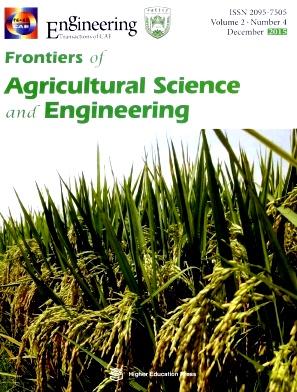柑桔‘orah’的倍间性杂交中,通过二次分裂恢复形成未还原的大孢子体有助于产生四倍体
IF 2.8
4区 农林科学
Q1 AGRONOMY
引用次数: 1
摘要
无籽水果在柑橘类新鲜水果市场上很受欢迎。通过二倍体×四倍体间倍性杂交生产三倍体被认为是无籽柑橘最有效和广泛使用的育种策略。虽然“奥拉”柑橘具有理想的感官品质,但果实中的种子削弱了其市场竞争力。为了培育出与‘奥拉’柑橘相似的无籽品种,我们以‘奥拉’柑橘为种子亲本,进行了3次2x × 4x杂交,再生出三倍体植株。共获得182个三倍体和36个四倍体植株。利用9个新的单核苷酸多态性(single nucleotide polymorphism, SNP)标记对这3个杂交组合的遗传来源进行分析,证实这3个杂交组合的三倍体和四倍体均为杂交种。此外,我们还证明了在‘Orah’柑橘中形成的2n大孢子体在这三个间倍性杂交中产生了四倍体。利用8个着丝粒周围SNP标记和9个着丝粒远端SNP标记对这些四倍体植株进行基因分型。从基因型分析来看,16个SNP位点亲本杂合率均小于50%,表明在种群和个体水平上,二次分裂恢复都是2n大配子形成的机制。这些三倍体杂交种丰富了无籽育种的可用种质。此外,四倍体杂交种作为亲本在柑橘无籽果实的倍性育种中具有重要价值。本文章由计算机程序翻译,如有差异,请以英文原文为准。
UNREDUCED MEGAGAMETOPHYTE FORMATION VIA SECOND DIVISION RESTITUTION CONTRIBUTES TO TETRAPLOID PRODUCTION IN INTERPLOIDY CROSSES WITH 'ORAH' MANDARIN (CITRUSRETICULATA)
ABSTRACT Seedless fruits are desirable in the citrus fresh fruit market. Triploid production via diploid × tetraploid interploidy crosses is thought to be the most efficient and widely-used strategy for the breeding of seedless citrus. Although ‘Orah’ mandarin has desirable organoleptic qualities, seeds in the fruits weaken its market competitiveness. To produce new seedless cultivars that are similar to ‘Orah’ mandarin, we performed three 2x × 4x crosses using ‘Orah’ mandarin as the seed parent to regenerate triploid plantlets. A total of 182 triploid and 36 tetraploid plantlets were obtained. By analyzing their genetic origins using nine novel single nucleotide polymorphism (SNP) markers, all of the triploids and tetraploids derived from these three crosses were proven to be hybrids. Also, we demonstrated that 2n megagametophyte formation in ‘Orah’ mandarin result in tetraploid production in these three interploidy crosses. These tetraploid plantlets were genotyped using eight pericentromeric SNP markers and nine centromere distal SNP markers. Based on the genotypes of the 2n megagametophytes, the parental heterozygosity rates in 16 SNP loci and all 2n megagametophytes were less than 50%, indicating that second division restitution was the mechanism underlying 2n megagametophyte formation at both the population and individual levels. These triploid hybrids enrich the germplasm available for seedless breeding. Moreover, the tetraploid hybrids are valuable as parents for ploidy breeding for the production of seedless citrus fruits.
求助全文
通过发布文献求助,成功后即可免费获取论文全文。
去求助
来源期刊
CiteScore
5.10
自引率
2.70%
发文量
33
期刊介绍:
Frontiers of Agricultural Science and Engineering (FASE) is an international journal for research on agricultural science and engineering. The journal’s aim is to report advanced and innovative scientific proceedings in agricultural field including Crop Science, Agricultural Biotechnology, Horticulture, Plant Protection, Agricultural Engineering, Forestry Engineering, Agricultural Resources, Animal Husbandry and Veterinary Medicine, Applied Ecology, Forestry and Fisheries. FASE is committed to provide a high level scientific and professional forum for researchers worldwide to publish their original findings and to utilize these novel findings to benefit the society.

 求助内容:
求助内容: 应助结果提醒方式:
应助结果提醒方式:


